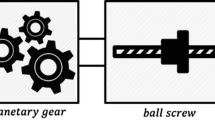Abstract
This paper presents a novel electromechanical brake (EMB) with automatic wear adjustment function, which has been ignored in most previous studies. With the aim of investigating the parameter characteristics of the EMB system and analyzing the proposed function, the mathematical models of the DC motor, motor friction, worm drive, ball screw and load are established in MATLAB/Simulink. The differences between the simulation and the experiment under step, triangular wave, square wave and sinusoidal input signals are discussed. The parameter characteristics of clamping force-motor current and clamping force-ball screw displacement are obtained, which also verifies that the established model is correct. The results demonstrate that the automatic wear adjustment function of the new EMB could guarantee that the brake stroke and response time remain consistent across each braking manoeuvre.
Similar content being viewed by others
References
Atia, M. R. A., Haggag, S. A. and Kamal, A. M. M. (2016). Enhanced electromechanical brake-by-wire system using sliding mode controller. J. Dynamic Systems, Measurement, and Control138, 4, 041003–1–041003–6.
Dinggen, L. I. (2012). Fuzzy control based on vehicle slip-ratio for electro-mechanical braking systems. J. Mechanical Engineering48, 20, 121–126.
Haggag, S. and Abidou, D. (2013). An approach to vehicle brake-by-wire optimal control tracking strategy. SAE Int. J. Passenger Cars-Mechanical Systems6, 1, 154–162.
Han, K., Kim, M. and Huh, K. (2012). Modeling and control of an electronic wedge brake. Proc. Institution of Mechanical Engineers, Part C: J. Mechanical Engineering Science226, 10, 2440–2455.
Helmut, W., Andreas, E. and Tobias, P. (2016). Automated Parking Brake and Method for Operating an Automated Parking Brake. Patent No. WO2016188899A1.
Huang, S., Zhou, C., Yang, L., Qin, Y., Huang, X. and Hu, B. (2016). Transient fault tolerant control for vehicle brake-by-wire systems. Reliability Engineering & System Safety, 149, 148–163.
Itani, K., De Bernardinis, A., Khatir, Z. and Jammal, A. (2016). Comparison between two braking control methods integrating energy recovery for a two-wheel front driven electric vehicle. Energy Conversion and Management, 122, 330–343.
Jeon, K., Park, J. I., Choi, S. and Yi, K. (2014). Electronic brake safety index for evaluating fail-safe control of brake-by-wire systems for improvement in the straight braking stability. Proc. Institution of Mechanical Engineers, Part D: J. Automobile Engineering228, 8, 873–893.
Jo, C., Hwang, S. and Kim, H. (2012). Clamping-force control for electromechanical brake. IEEE Trans. Vehicular Technology59, 7, 3205–3212.
Jong, S. K. (2015). Apparatus and Method for Initializing of Electromechanical Brake. Patent No. US20150136538A1.
Karakoc, K., Suleman, A. and Park, E. J. (2015). Analytical modeling of eddy current brakes with the application of time varying magnetic fields. Applied Mathematical Modelling40, 2, 1168–1179.
Lee, C. F. and Manzie, C. (2016). Active brake judder attenuation using an electromechanical brake-by-wire system. IEEE/ASME Trans. Mechatronics21, 6, 2964–2976.
Lee, H. (2014). A study on braking system using fully electric brake system. Proc. IEEE Int. Conf. Industrial Technology (ICIT), Busan, Korea.
Lee, J., Dede, E. M., Banerjee, D. and Iizuka, H. (2012). Magnetic force enhancement in a linear actuator by air-gap magnetic field distribution optimization and design. Finite Elements in Analysis and Design, 58, 44–52.
Li, J., Mengchun, W., He, R. and Zhang, J. (2011). A design of electromechanical brake system triple-loop controllers using frequency domain method based on Bode plote. Proc. Int. Conf. Transportation, Mechanical, and Electrical Engineering (TMEE), Changchun, China.
Márton, L. and Lantos, B. (2009). Control of mechanical systems with stribeck friction and backlash. Systems & Control Letters58, 2, 141–147.
Miller, J. I., Henderson, L. M. and Cebon, D. (2013). Designing and testing an advanced pneumatic braking system for heavy vehicles. Proc. Institution of Mechanical Engineers, Part C: J. Mechanical Engineering Science227, 8, 1715–1729.
Lostado, R., Roldán, P. V., Martinez, R. F. and Mac Donald, B. J. (2016). Design and optimization of an electromagnetic servo braking system combining finite element analysis and weight-based multi-objective genetic algorithms. J. Mechanical Science and Technology30, 8, 3591–3605.
The United Nations Economic Commission for Europe (2014). UNECE Regulation No. 13-H. Uniform Provisions Concerning the Approval of Vehicles of Categories M, N and O with Regard to Braking. Geneva: UNECE.
Villanueva, P. M., Lorza, R. L. and Bobadilla, M. C. (2016). Pugh’s total design: The design of an electromagnetic servo brake with ABS function — A case study. Concurrent Engineering24, 3, 227–239.
Wang, B., Guo, X., Zhang, C., Xiong, Z. and Zhang, J. (2015). Modeling and control of an integrated electric parking brake system. J. Franklin Institute352, 2, 626–644.
Yu, L. Y. (2007). Performance evaluation and test of anti-lock braking system hydraulic system. J. Mechanical Engineering43, 9, 40–46.
Yu, L. Y. and Zhao, W. Z. (2013). Research on parameter optimization of automobile brake by wire system. Computer Simulation, 30, 163–166.
Yu, L. Y., Zhao, W. Z. and Yi, J. B. (2012). Modeling and analysis of brake by wire system in electric vehicle. Applied Mechanics and Materials, 249–250, 622–627.
Acknowledgement
We gratefully acknowledge the support of the Natural Science Foundation of Zhejiang Province, China (Grant NO: LY13E050003), Scientific Research Projects of Zhejiang Education Department, China (Grant NO: Y201635253), and Visiting Engineer Project of Zhejiang Education Department, China (Grant NO: FG2016022). We thank Professor P. C. Huang and Professor G. F. Wang for enlightening discussions. We thank the assistance of M. H. XU and Y. X. LU in preparing the experiment platform.
Author information
Authors and Affiliations
Corresponding author
Additional information
Publisher’s Note
Springer Nature remains neutral with regard to jurisdictional claims in published maps and institutional affiliations.
Rights and permissions
About this article
Cite this article
Fu, Y.F., Hu, X.H., Wang, W.R. et al. Simulation and Experimental Study of a New Electromechanical Brake with Automatic Wear Adjustment Function. Int.J Automot. Technol. 21, 227–238 (2020). https://doi.org/10.1007/s12239-020-0022-y
Received:
Revised:
Accepted:
Published:
Issue Date:
DOI: https://doi.org/10.1007/s12239-020-0022-y




